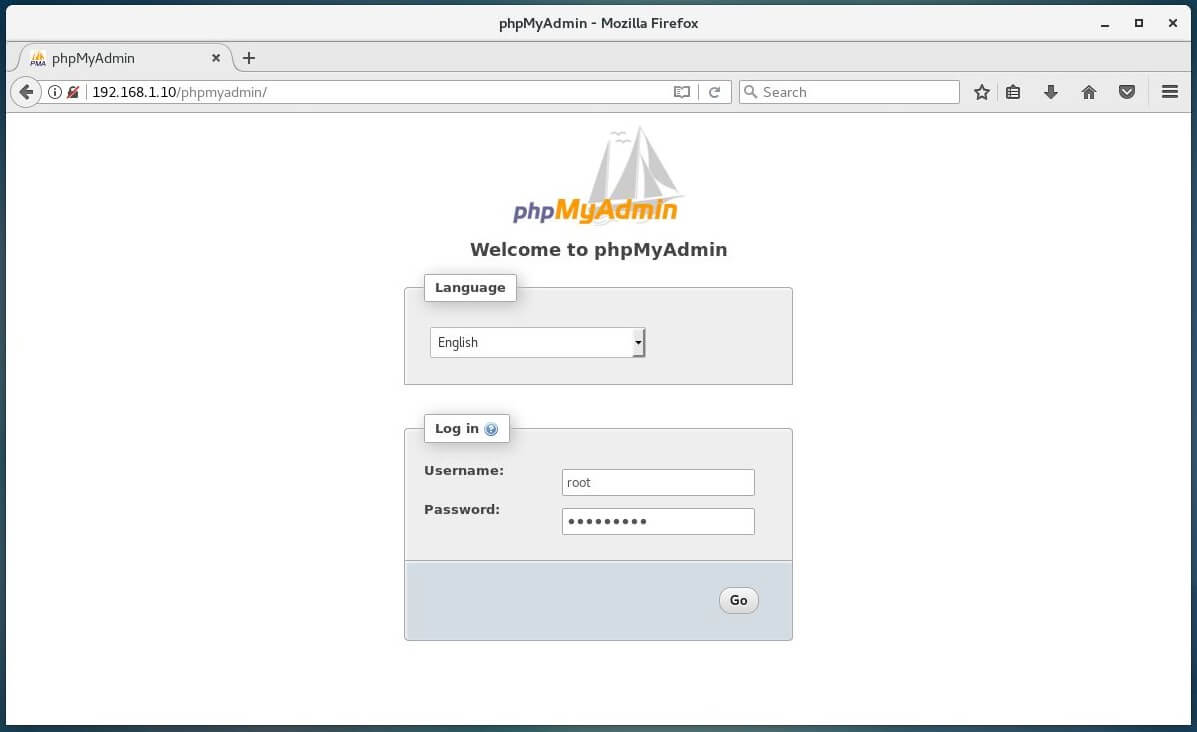

- #Install phpmyadmin centos 7 for free#
- #Install phpmyadmin centos 7 how to#
- #Install phpmyadmin centos 7 install#
- #Install phpmyadmin centos 7 software#
This tool will ask you for your current database root password. Now it is best to configure your MariaDB ( MySQL) in a way to disable some test data and test accounts and assign a password to your root user. #Start Apache (PHP will start with Apache as module)īy now, your system should have all necessary packages installed and the services up and running.
#Install phpmyadmin centos 7 install#
Sudo yum install httpd mariadb-server mariadb php php-mysql phpmyadmin -y
#Install phpmyadmin centos 7 software#
#Install Apache, MariaDB (MySQL), PHP (with MySQL support and phpMyAdmin which is a free software tool written in PHP, intended to handle the administration of MySQL over the Web) To perform the installation, please execute the following as a user with administrative rights: In this guide we kept the information to the bare minimum about what is what.
#Install phpmyadmin centos 7 for free#
Give it a try! It’s for free and does not require you to be a Shadow Hosting’s customer and can work without registration.2 June 2017 in GNU/Linux tagged apache / CentOS / centos 7 / GNU / lamp / linux / mysql / php / phpmyadmin by Tuxįollowing you will find the commands to perform the installation of the LAMP stack ( Apache, MySQL, PHP) and phpMyAdmin on a GNU/ Linux CentOS 7. You can find multiple technical and hacking tools. Open up, break it, fix it, add stuff in it and that’s how you learn with your screwdriver! Get yourself an affordable VPS Hosting with Shadow Hosting.Īlso, make sure you’re well equipped with our developer’s hub consisting of multiple tools for pen-testers and developers at ShadowCrypt. Totally affordable and best for both the learning and production environment. Assuming you’re new to Linux computing, we recommend you to buy Screwdriver Plan(The first one with 4 GB RAM). New to VPS and Linux? Want to learn new Linux computing and stuff? Get yourself a VPS and start making and breaking things. service httpd restartĪfter this, go to your browser and open “ It will show up the PHPMyAdmin interface. Step 4 – Finalizing & Restartingīut for it to be in effect, you have to restart the Apache. Alternatively, you can add more of those lines after the new line and allow PHPMyAdmin to open at whatever address you want. It means, “/phpmyadmin” will now show 404 error and “/thisismyphpmyadmin” will open the PHPMyAdmin interface. Save it by pressing CTRL + X and then press “Y” and then “Enter” key. …Where “/thisismyphpmyadmin” is the new directory. Alias /thisismyphpmyadmin /usr/share/phpMyAdmin Now add this line just after those commented lines.

by adding “#” or symbolic “hash” to comment on those lines. …and change them to: #Alias /phpMyAdmin /usr/share/phpMyAdmin Now find these lines: Alias /phpMyAdmin /usr/share/phpMyAdmin All you have to do is change this from that.

Step 3 – Changing Few LinesĬhanging the director for PHPMyAdmin is super easy. The reason why I included the installation of nano is that it doesn’t come by default in many versions of CentOS packages offered by hosting providers. The right directory for nf by default in /etc/httpd/conf.d. Step 2 – The Right Directory & Text Editor
#Install phpmyadmin centos 7 how to#
You can check our article on how to fix the 403 Forbidden error. In a fresh installation of PHPMyAdmin, you’re likely to face a “403 Forbidden Error”. You can also check the article on how to connect to a VPS using putty. It will help you to connect to your VPS/server. You can do it by using the SSH Client called Putty. The most basic thing is obviously, connecting to the VPS. Getting Started with Changing PHPMyAdmin Directory If not, you can check the article on how to install PHPMyAdmin in CentOS 7 machine. Since we’re changing the directory here, we’d assume that we already have installed PHPMyAdmin in the machine.


 0 kommentar(er)
0 kommentar(er)
